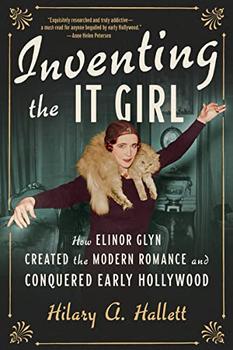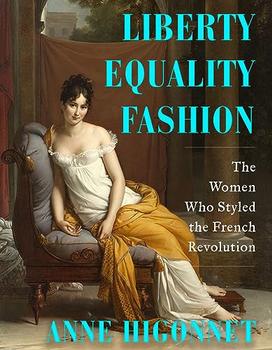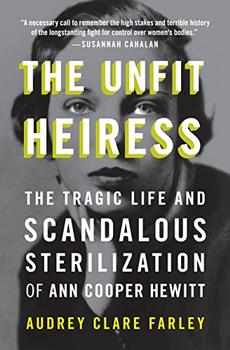Summary | Excerpt | Reviews | Beyond the book | Read-Alikes | Genres & Themes | Author Bio

How Elinor Glyn Created the Modern Romance and Conquered Early Hollywood
by Hilary A. HallettIf you've ever read a romance novel or seen a film (or, at this point, seen a parody) featuring scattered rose petals, a sensuously draped tiger skin rug, or a woman holding a rose between her teeth, you can thank novelist and screenwriter Elinor Glyn. Her long and groundbreaking career spanned the transition from Victorian repression to Edwardian excess, and she wholeheartedly embraced the storytelling potential of the early Hollywood years, all while navigating a thorny path of sex and women's sexuality, breaking taboos at every turn.
Born Elinor Sutherland in 1864 and raised primarily on Jersey in the British Channel Islands, Elinor was known as "Nell" to her family and friends. She and her older sister Lucy both grew up questioning the prevailing cultural narrative of women's submission to men, as they saw their mother constantly subvert her own desires for those of her domineering and miserly second husband. Often left to her own devices, Nell found both solace and perspective in her unfettered access to the family library. Armed with an autodidact's arsenal of information and ideas, a quick wit and a distinctive head of red hair, Nell entered society as a vivacious and memorable figure.
Following an ultimately unsatisfying marriage and difficult childbirths, Nell endured a series of treatments for neurasthenia — a catch-all medical diagnosis common at the time and primarily given to women who exhibited any signs of mental health issues — that prompted her first forays into writing. Her early fashion columns, written in the form of letters, were the springboard for a novel that became a bestseller (a new publishing concept at the time). But it was the publication of her 1907 novel Three Weeks that cemented Glyn's reputation for pushing the envelope of sensual depictions on the page. Critics were both scandalized (one called it "shameless and shameful fiction") and intrigued, but audiences on both sides of the Atlantic (outside Boston and other cities where it was banned) made the book a sensation. For decades afterward, showing a character in a film or advertisement just holding Three Weeks was shorthand for a certain kind of sexual licentiousness or liberation.
Nell became a widow after her husband had already squandered the family's finances, making her responsible for her daughters' financial well-being. So among (many) other facets, Hilary Hallett's biography of Elinor Glyn is a fascinating portrait of a woman savvily using her writing talent, her celebrity cachet and her amazing personal and professional connections to become a success. Part of this, of course, is alluded to in the book's title — in her later years, Nell was among a cohort of commercially successful writers who were recruited to work for the newly emerging Hollywood film industry. Glyn wholeheartedly embraced this new art form, and her film It launched the career of Clara Bow, the original "It Girl," a description for an actress whose combination of beauty and sex appeal results in a magnetic onscreen presence and an equally vivacious presence in the real-world social scene.
Hallett, who is a professor of history at Columbia University and whose first book, Go West, Young Women, interrogated the sexual politics of the silent film industry, unsurprisingly incorporates and documents an incredible amount of research in this first significant biography of Elinor Glyn. At times, especially at the beginning, Hallett falls into the common trap of imposing fictional techniques, especially regarding the thoughts and emotions of her subject (e.g., "it was time to head upstairs, her thoughts circling around Thackeray's heroine, Becky Sharp") in a way that sticks out as inauthentic in what is otherwise a fairly straightforward biographical narrative. The writing could also, at points, have used more rigorous editing to eliminate numerous dangling participles and other grammatical issues.
But, in a biography that weighs in at nearly 400 pages without endnotes, these become relatively minor concerns. Instead, readers will walk away from Inventing the It Girl with a greater appreciation for this largely unknown and certainly underappreciated trailblazer and iconoclast. Fans of celebrity biography will find much to celebrate here, as many of Nell's remarkable circle of friends and acquaintances — including Rudolf Valentino, Sarah Bernhardt, Daisy Greville and of course Clara Bow — have cameos. And those who value social history more generally will appreciate how Hallett's biography carefully interrogates the ways in which gender, class and geography shaped Nell's options and opportunities, as well as her understanding of how to expand the boundaries of sexuality on page and screen. Playing out against the backdrop of a sea change with regards to women's rights and to the understanding of sexuality more generally, Inventing the It Girl is both a lively portrait of a memorable figure and a thoughtful chronicle of the times she was shaped by — and how she shaped them in return.
![]() This review was originally published in The BookBrowse Review in September 2022, and has been updated for the
May 2024 edition.
Click here to go to this issue.
This review was originally published in The BookBrowse Review in September 2022, and has been updated for the
May 2024 edition.
Click here to go to this issue.

If you liked Inventing the It Girl, try these:

by Anne Higonnet
Published 2024
Three women led a fashion revolution and turned themselves into international style celebrities.

by Audrey Farley
Published 2023
For readers of The Immortal Life of Henrietta Lacks and The Phantom of Fifth Avenue, a page-turning drama of fortunes, eugenics and women's reproductive rights framed by the sordid court battle between Ann Cooper Hewitt and her socialite mother.
Your guide toexceptional books
BookBrowse seeks out and recommends the best in contemporary fiction and nonfiction—books that not only engage and entertain but also deepen our understanding of ourselves and the world around us.